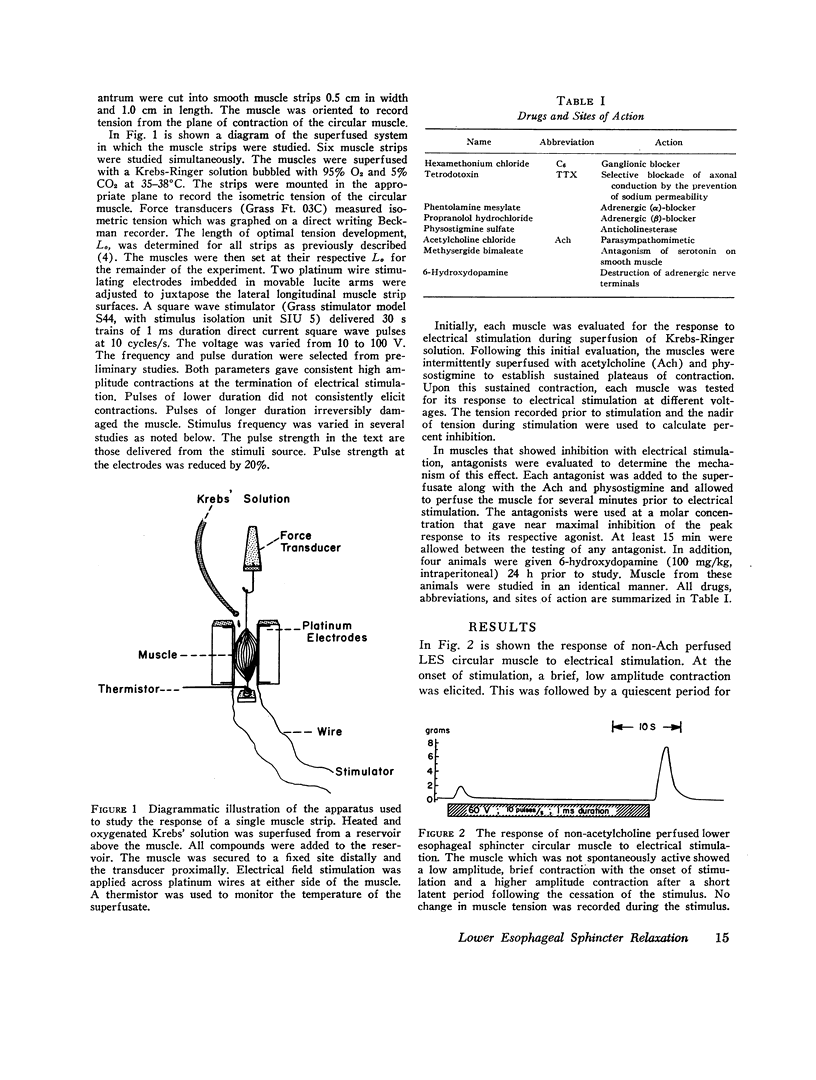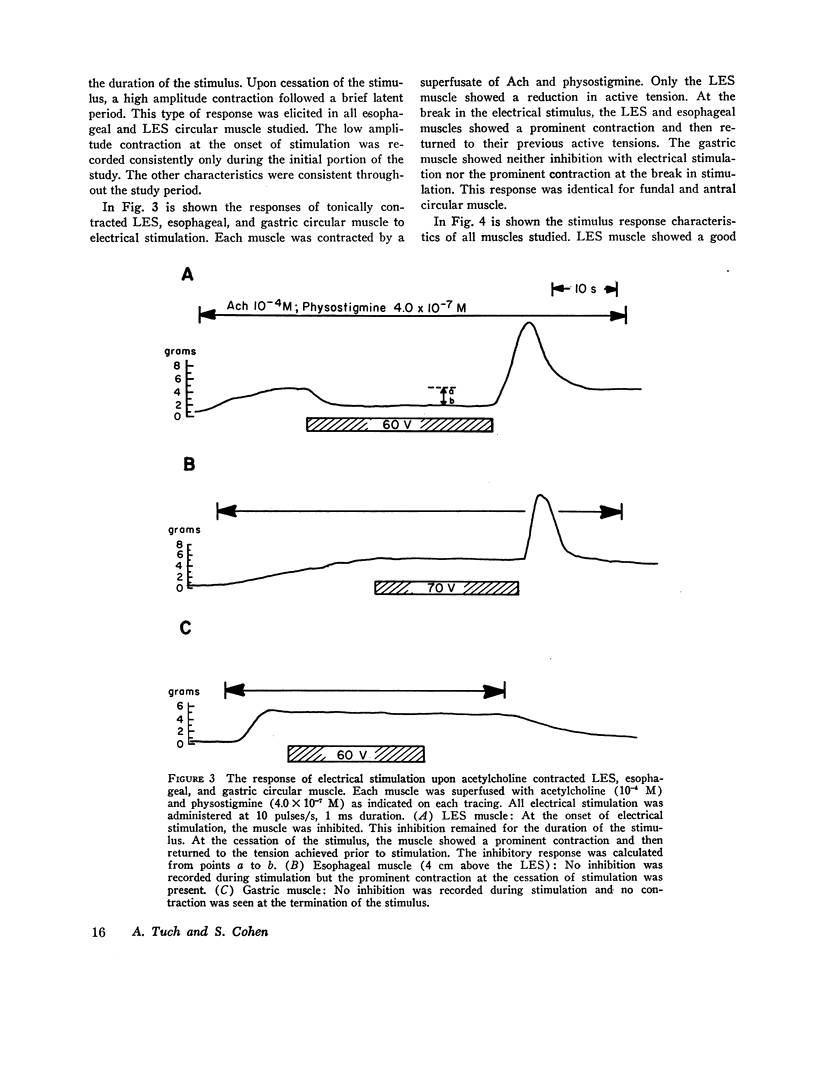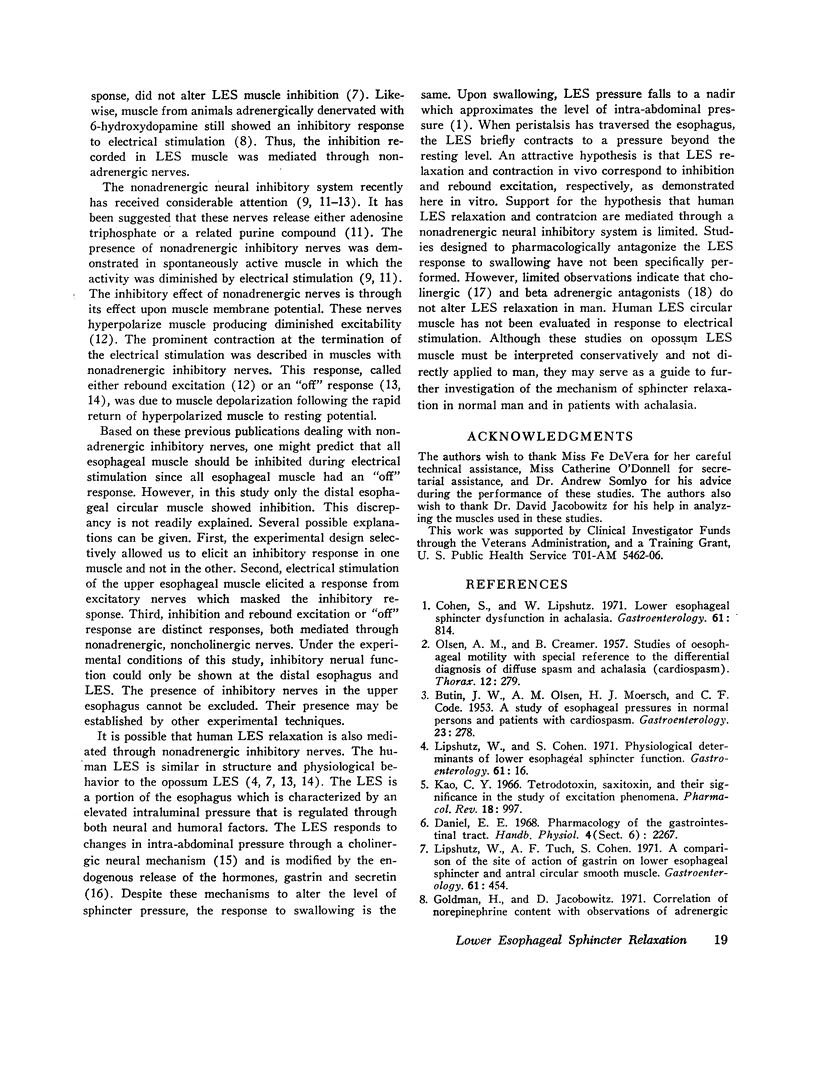Abstract
The purpose of this study was to determine the physiological mechanism of lower esophageal sphincter (LES) relaxation. Circular muscle of the esophagus, LES, and stomach were evaluated for their inhibitory response to electrical stimulation during a maintained tonic contraction produced by a superfusion of acetylcholine and physostigmine. Only the circular muscle of the distal esophagus showed an inhibitory response to electrical stimulation. The maximal inhibition of LES muscle was 63.9±5.9 (mean±SE)% of the acetylcholine produced tension and occurred at 80 V. Upper esophageal and gastric muscle were not inhibited. The inhibitory response of the LES muscle was antagonized by tetrodotoxin and hexamethonium but not by other specific antagonists. Adrenergic nerve destruction following 6-hydroxydopamine also did not abolish the LES inhibition. These data indicate that the distal esophagus, at the zone of the manometrically determined LES, is characterized by a nonadrenergic neural inhibitory system. We suggest that these nerves may mediate LES relaxation.
Full text
PDF






Selected References
These references are in PubMed. This may not be the complete list of references from this article.
- BUTIN J. W., OLSEN A. M., MOERSCH H. J., CODE C. F. A study of esophageal pressures in normal persons and patients with cardiospasm. Gastroenterology. 1953 Feb;23(2):278–293. [PubMed] [Google Scholar]
- Beani L., Bianchi C., Crema A. Vagal non-adrenergic inhibition of guinea-pig stomach. J Physiol. 1971 Sep;217(2):259–279. doi: 10.1113/jphysiol.1971.sp009570. [DOI] [PMC free article] [PubMed] [Google Scholar]
- Bennett M. R. Rebound excitation of the smooth muscle cells of the guinea-pig taenia coli after stimulation of intramural inhibitory nerves. J Physiol. 1966 Jul;185(1):124–131. doi: 10.1113/jphysiol.1966.sp007975. [DOI] [PMC free article] [PubMed] [Google Scholar]
- Burnstock G., Campbell G., Satchell D., Smythe A. Evidence that adenosine triphosphate or a related nucleotide is the transmitter substance released by non-adrenergic inhibitory nerves in the gut. Br J Pharmacol. 1970 Dec;40(4):668–688. doi: 10.1111/j.1476-5381.1970.tb10646.x. [DOI] [PMC free article] [PubMed] [Google Scholar]
- Christensen J., Lund G. F. Esophageal responses to distension and electrical stimulation. J Clin Invest. 1969 Feb;48(2):408–419. doi: 10.1172/JCI105998. [DOI] [PMC free article] [PubMed] [Google Scholar]
- Cohen S., Lipshutz W. Hormonal regulation of human lower esophageal sphincter competence: interaction of gastrin and secretin. J Clin Invest. 1971 Feb;50(2):449–454. doi: 10.1172/JCI106512. [DOI] [PMC free article] [PubMed] [Google Scholar]
- Cohen S., Lipshutz W. Lower esophageal sphincter dysfunction in achalasia. Gastroenterology. 1971 Dec;61(6):814–820. [PubMed] [Google Scholar]
- Crispin J. S., McIver D. K., Lind J. F. Manometric study of the effect of vagotomy on the gastroesophageal sphincter. Can J Surg. 1967 Jul;10(3):299–303. [PubMed] [Google Scholar]
- Goldman H., Jacobowitz D. Correlation of norepinephrine content with observations of adrenergic nerves after a single dose of 6-hydroxydopamine in the rat. J Pharmacol Exp Ther. 1971 Jan;176(1):119–133. [PubMed] [Google Scholar]
- Kao C. Y. Tetrodotoxin, saxitoxin and their significance in the study of excitation phenomena. Pharmacol Rev. 1966 Jun;18(2):997–1049. [PubMed] [Google Scholar]
- Lind J. F., Crispin J. S., McIver D. K. The effect of atropine on the gastroesophageal sphincter. Can J Physiol Pharmacol. 1968 Mar;46(2):233–238. doi: 10.1139/y68-039. [DOI] [PubMed] [Google Scholar]
- Lipshutz W., Cohen S. Physiological determinants of lower esophageal sphincter function. Gastroenterology. 1971 Jul;61(1):16–24. [PubMed] [Google Scholar]
- Lipshutz W., Hughes W., Cohen S. The genesis of lower esophageal sphincter pressure: its identification through the use of gastrin antiserum. J Clin Invest. 1972 Mar;51(3):522–529. doi: 10.1172/JCI106840. [DOI] [PMC free article] [PubMed] [Google Scholar]
- Lipshutz W., Tuch A. F., Cohen S. A comparison of the site of action of gastrin I on lower esophageal sphincter and antral circular smooth muscle. Gastroenterology. 1971 Oct;61(4):454–460. [PubMed] [Google Scholar]
- Lund G. F., Christensen J. Electrical stimulation of esophageal smooth muscle and effects of antagonists. Am J Physiol. 1969 Nov;217(5):1369–1374. doi: 10.1152/ajplegacy.1969.217.5.1369. [DOI] [PubMed] [Google Scholar]
- OLSEN A. M., CREAMER B. Studies of oesophageal motility, with special reference to the differential diagnosis of diffuse spasm and achalasia (cardiospasm). Thorax. 1957 Dec;12(4):279–289. doi: 10.1136/thx.12.4.279. [DOI] [PMC free article] [PubMed] [Google Scholar]
- Zfass A. M., Prince R., Allen F. N., Farrar J. T. Inhibitory beta adrenergic receptors in the human distal esophagus. Am J Dig Dis. 1970 Apr;15(4):303–310. doi: 10.1007/BF02239282. [DOI] [PubMed] [Google Scholar]


